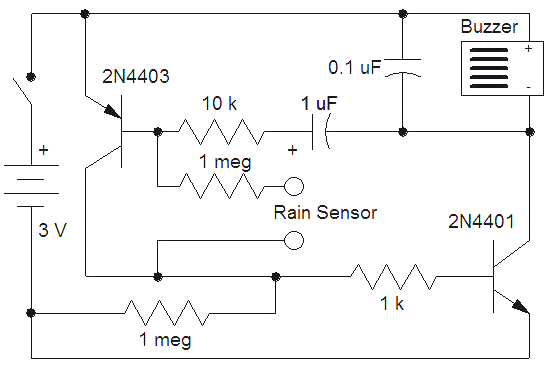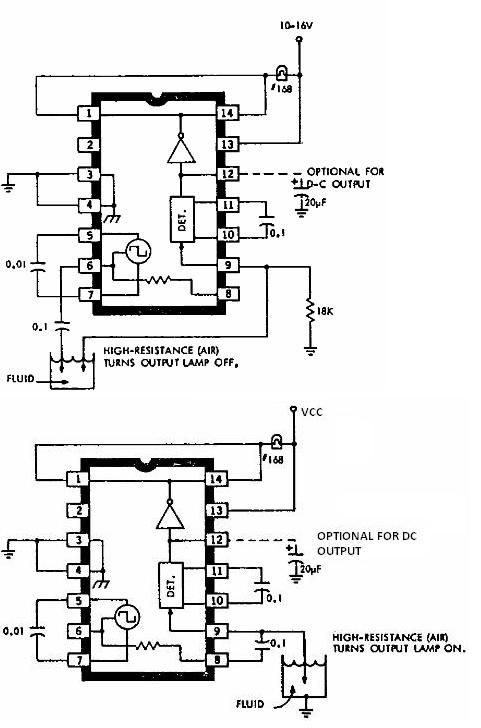
overheat detector alarm lm35

The core of this overheat detector circuit features a precision integrated temperature sensor, the LM35 (IC1). This sensor provides a linear and directly proportional output in millivolts over a temperature range of 0 to +155 degrees Celsius. The LM35 generates an output voltage of 10 mV per Kelvin change in temperature, while consuming minimal current, resulting in low self-heating in still air. The output from the LM35 is connected to the non-inverting input of a comparator configured with a CA3130 operational amplifier (IC2). A voltage divider network consisting of R3 and P1 sets the threshold voltage at the inverting input of the op-amp, which defines the adjustable temperature trip level that activates the circuit. When the measured temperature surpasses the user-defined threshold, the comparator outputs a high signal of approximately 2.2 V, which forward-biases transistor T1. This action also activates transistor T2, providing sufficient voltage to the oscillator circuit around IC3. The 555 timer, configured in astable mode, directly drives a piezoelectric buzzer (Bz1) to emit a loud alert. The components R7, R8, and C4 regulate the on/off rhythm of the sounder. A transistor-based relay driver can be activated from the emitter of T1 (TP1). Additionally, substituting the piezo sounder with an appropriate relay allows for the control of high-power flashers, sirens, or horns powered by the AC mains supply.
The overheat detector circuit is designed for reliable temperature monitoring and alerting in various applications, such as industrial equipment, home appliances, or automotive systems. The LM35 temperature sensor is chosen for its high accuracy and linearity, making it suitable for precise temperature measurements. The CA3130 op-amp comparator is utilized for its low input offset voltage and high gain, ensuring that even small changes in temperature can trigger the alarm system effectively.
The adjustable voltage divider formed by R3 and P1 allows users to set the trip point according to specific requirements, enhancing the circuit's versatility. The output from the comparator, when activated, not only drives the buzzer but also enables the subsequent transistor stages. Transistor T1 acts as a switch that controls the power to the oscillator circuit, while T2 ensures that the 555 timer operates reliably. The 555 timer in astable mode generates a continuous square wave, which is then converted into an audible sound by the piezoelectric buzzer. The timing components R7, R8, and C4 can be adjusted to modify the frequency and duration of the sound, allowing customization of the alert signal.
Furthermore, the circuit's design includes provisions for integrating a relay driver, making it adaptable for controlling larger loads. By replacing the piezo buzzer with a relay, the circuit can activate various high-power devices, providing a practical solution for alerting users in critical situations. This feature expands the usability of the overheat detector beyond simple auditory alerts, enabling it to serve as an integral part of a comprehensive safety system.At the heart of this over heat detector circuit is a precision integrated temperature sensor type LM35 (IC1), which provides an accurately linear and directly proportional output in mV, over the zero to +155 degrees C temperature range. The LM35 develops an output voltage of 10 mV/K change in measured temperature. Designed to draw a minimal curren t of its own, the LM35 has very low self heating in still air. Here the output of the LM35 is applied to the non-inverting input of a comparator wired around a CA3130 opamp (IC2). A voltage divider network R3-P1 sets the threshold voltage, at the inverting input of the opamp. The threshold voltage determines the adjustable temperature trip level at which the circuit is activated.
When the measured temperature exceeds the user-defined level, the comparator pulls its output High to approx. 2. 2 V causing transistor T1 to be forward biased instantly. T2 is also switched on, supplying the oscillator circuit around IC3 with sufficient voltage to start working.
The 555 set up in astable mode directly drives active piezoelectric buzzer Bz1 to raise a loud alert. Components R7, R8 and C4 determine the on/off rhythm of the sounder. A transistor based relay driver may be driven off the emitter of T1 (TP1). Similarly, replacing the piezo sounder with a suitable relay allows switching of high-power flashers, sirens or horns working on the AC mains supply.
🔗 External reference
The overheat detector circuit is designed for reliable temperature monitoring and alerting in various applications, such as industrial equipment, home appliances, or automotive systems. The LM35 temperature sensor is chosen for its high accuracy and linearity, making it suitable for precise temperature measurements. The CA3130 op-amp comparator is utilized for its low input offset voltage and high gain, ensuring that even small changes in temperature can trigger the alarm system effectively.
The adjustable voltage divider formed by R3 and P1 allows users to set the trip point according to specific requirements, enhancing the circuit's versatility. The output from the comparator, when activated, not only drives the buzzer but also enables the subsequent transistor stages. Transistor T1 acts as a switch that controls the power to the oscillator circuit, while T2 ensures that the 555 timer operates reliably. The 555 timer in astable mode generates a continuous square wave, which is then converted into an audible sound by the piezoelectric buzzer. The timing components R7, R8, and C4 can be adjusted to modify the frequency and duration of the sound, allowing customization of the alert signal.
Furthermore, the circuit's design includes provisions for integrating a relay driver, making it adaptable for controlling larger loads. By replacing the piezo buzzer with a relay, the circuit can activate various high-power devices, providing a practical solution for alerting users in critical situations. This feature expands the usability of the overheat detector beyond simple auditory alerts, enabling it to serve as an integral part of a comprehensive safety system.At the heart of this over heat detector circuit is a precision integrated temperature sensor type LM35 (IC1), which provides an accurately linear and directly proportional output in mV, over the zero to +155 degrees C temperature range. The LM35 develops an output voltage of 10 mV/K change in measured temperature. Designed to draw a minimal curren t of its own, the LM35 has very low self heating in still air. Here the output of the LM35 is applied to the non-inverting input of a comparator wired around a CA3130 opamp (IC2). A voltage divider network R3-P1 sets the threshold voltage, at the inverting input of the opamp. The threshold voltage determines the adjustable temperature trip level at which the circuit is activated.
When the measured temperature exceeds the user-defined level, the comparator pulls its output High to approx. 2. 2 V causing transistor T1 to be forward biased instantly. T2 is also switched on, supplying the oscillator circuit around IC3 with sufficient voltage to start working.
The 555 set up in astable mode directly drives active piezoelectric buzzer Bz1 to raise a loud alert. Components R7, R8 and C4 determine the on/off rhythm of the sounder. A transistor based relay driver may be driven off the emitter of T1 (TP1). Similarly, replacing the piezo sounder with a suitable relay allows switching of high-power flashers, sirens or horns working on the AC mains supply.
🔗 External reference





